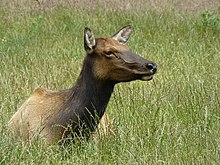Roosevelt elk
| Roosevelt Elk | |
|---|---|

| |
| Male (bull) at Northwest Trek, Washington, US | |

| |
| Female at Prairie Creek Redwoods State Park, California, US | |
| Scientific classification | |
| Domain: | Eukaryota |
| Kingdom: | Animalia |
| Phylum: | Chordata |
| Class: | Mammalia |
| Order: | Artiodactyla |
| Family: | Cervidae |
| Subfamily: | Cervinae |
| Genus: | Cervus |
| Species: | |
| Subspecies: | C. c. roosevelti
|
| Trinomial name | |
| Cervus canadensis roosevelti | |
The Roosevelt elk (Cervus canadensis roosevelti), also known as Olympic elk, is the largest of the four surviving subspecies of elk in North America.[1] They live in the rain forests of the Pacific Northwest and were introduced to Kodiak, Alaska's Afognak and Raspberry Islands in 1928.[2][3] The desire to protect the elk was one of the primary forces behind the establishment of the Mount Olympus National Monument (later Olympic National Park) in 1909.[4]
Description
Adults grow to around 6–10 ft (1.8–3 m) in length and stand 2.5–5 ft (0.75–1.5 m) tall at the shoulder.[3] Elk bulls generally weigh between 700 and 1100 lb (300–500 kg), while cows weigh 575–625 lb (260–285 kg).[1] Some mature bulls from Raspberry Island in Alaska have weighed nearly 1300 lb (600 kg).[1]
From late spring to early fall, Roosevelt elk feed on herbaceous plants, such as grasses and sedges.[3] During winter months, they feed on woody plants, including highbush cranberry, elderberry, devil's club, and newly planted seedlings (Douglas-fir and western redcedar).[3] Roosevelt elk are also known to eat blueberries, mushrooms, lichens, and salmonberries.[3]
Life cycle
In the wild, Roosevelt elk rarely live beyond 12 to 15 years, but in captivity have been known to live over 25 years.[3]
Reintroduction
This elk subspecies was reintroduced to British Columbia's Sunshine Coast from Vancouver Island in 1986.[5]
See also
References
- ^ a b c Robb, Bob (January 2001). The Ultimate Guide to Elk Hunting. The Lyons Press. ISBN 1-58574-180-9.
- ^ Nancy Gates, ed. (November 2006). The Alaska Almanac: Facts about Alaska 30th Anniversary Edition. Alaska Northwest Books. ISBN 0-88240-652-3.
- ^ a b c d e f Rennick, Penny (November 1996). Mammals of Alaska. Alaska Geographic Society. ISBN 1-56661-034-6.
- ^ Houston, Douglas; Jenkins, Kurt. "Roosevelt Elk Ecology". Retrieved 2007-12-28.
- ^ http://coastalinletadventures.com/bc-roosevelt-elk-hunting-british-columbia-canada.htm
External links
